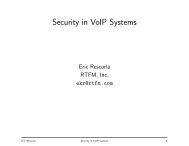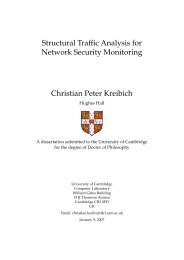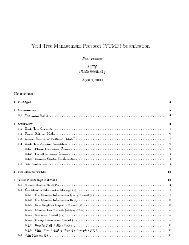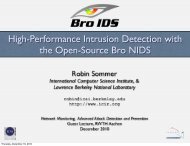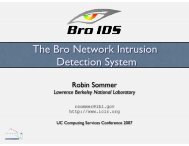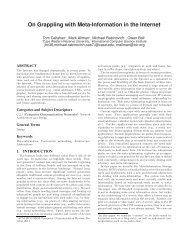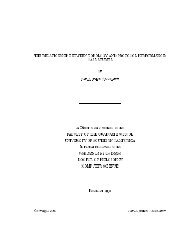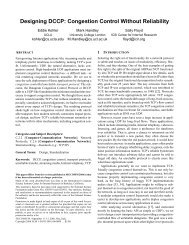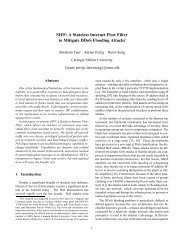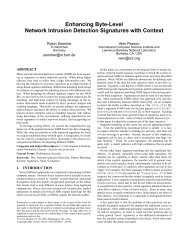Characteristics of Internet Background Radiation - UNC Computer ...
Characteristics of Internet Background Radiation - UNC Computer ...
Characteristics of Internet Background Radiation - UNC Computer ...
You also want an ePaper? Increase the reach of your titles
YUMPU automatically turns print PDFs into web optimized ePapers that Google loves.
Number <strong>of</strong> Packets Per IP (per hour)<br />
0.2<br />
0.1<br />
RST<br />
Syn-Ack<br />
Comm Adm Proh (Host)<br />
TTL Exceeded<br />
Number <strong>of</strong> Packets per IP (per hour)<br />
0.2<br />
0.1<br />
RST<br />
Syn-Ack<br />
Comm Adm Proh (Host)<br />
TTL Exceeded<br />
Number <strong>of</strong> Packets per IP (per hour)<br />
0.2<br />
0.1<br />
RST<br />
Syn-Ack<br />
TTL Exceeded<br />
0<br />
Wed Thu Fri Sat Sun Mon Tue Wed<br />
Day <strong>of</strong> the week<br />
0<br />
Wed Thu Fri Sat Sun Mon Tue Wed<br />
Day <strong>of</strong> the week<br />
0<br />
Wed Thu Fri Sat Sun Mon Tue Wed<br />
Day <strong>of</strong> the Week<br />
(a) Backscatter at UW I<br />
(b) Backscatter at UW II<br />
(c) Backscatter at LBL<br />
Number <strong>of</strong> Packets per IP (per hour)<br />
0.2<br />
0.1<br />
RST<br />
Syn-Ack<br />
Other backscatter<br />
Number <strong>of</strong> Packets per IP (per hour)<br />
2×10 -2<br />
1×10 -2<br />
5×10 -3<br />
TTL Excd in Transit<br />
Comm Adm Prohibited<br />
Comm Adm Prohibited (Host)<br />
Port Unreachable<br />
Host Unreachable<br />
0<br />
Fri Sat Sun Mon Tue Wed Thu<br />
Day <strong>of</strong> the week<br />
0<br />
Fri Sat Sun Mon Tue Wed Thu<br />
Day <strong>of</strong> the week<br />
(d) Syn-Acks and RSTs in Class A<br />
(e) Remaining Backscatter in Class A<br />
Figure 7: Time series <strong>of</strong> weekly backscatter in the four networks. Note that Class A is shown in two charts, the second one (e) showing<br />
the other components <strong>of</strong> backscatter besides the dominant RST, SYN-ACK’s.<br />
two weeks. The backscatter in the two UW networks looks highly<br />
similar both in terms <strong>of</strong> volume and variability. This can be observed<br />
both in the TCP RSTs/SYN-ACKs and the two surges in<br />
ICMP TTL-Exceeded shown in Figures 7(a) and (b), and makes<br />
sense if the spo<strong>of</strong>ed traffic which is eliciting the backscatter is uniformly<br />
distributed across the UW addresses. The only difference<br />
between the networks is that UW I tends to receive more “Communication<br />
administratively prohibited” ICMP messages than UW II.<br />
We do yet have an explanation why. While we see some common<br />
spikes in the SYN-ACKS at the Class A and UW networks, there<br />
seem to be significant differences in the RSTs. Another notable difference<br />
is that the Class A network attracts much more backscatter<br />
in other categories, as shown in Figure 7(e).<br />
The LBL graph shown in Figure 7(c) belongs to a different week<br />
and displays a quite different pattern than that <strong>of</strong> UW. We note that<br />
the backscatter in the UW networks for the same week (not shown<br />
here) shows a very similar pattern as at LBL for the dominant traffic<br />
types (TCP RSTs/SYN-ACKs and ICMP TTL-Exceeded). This is<br />
not surprising, because the two UW networks and the LBL network<br />
belong to the same /8 network. On the other hand, the LBL network<br />
seems to receive far fewer scans in the other categories.<br />
A significant portion <strong>of</strong> ICMP host-unreach messages we<br />
see at Class A are responses to UDP packets with spo<strong>of</strong>ed source<br />
addresses from port 53 to port 1026. We first thought we were<br />
seeing backscatters <strong>of</strong> DNS poisoning attempts, but then we found<br />
that we are also seeing the UDP packets in other networks as well.<br />
Examining these packets reveals that they are not DNS packets, but<br />
rather Windows Messenger Pop-Up spams, as discussed in the next<br />
section.<br />
5. ACTIVITIES IN BACKGROUND RADI-<br />
ATION<br />
In this section we will first divide the traffic by ports and present<br />
a tour <strong>of</strong> dominant activities on the popular ports. Then we will<br />
add the temporal element to our analysis to see how the volume <strong>of</strong><br />
activities vary over time.<br />
5.1 Details per Port<br />
We rank activities’ popularity mostly by number <strong>of</strong> source IPs,<br />
rather than by packet or byte volume, for the following reasons.<br />
First, our filtering algorithm is biased against sources that try to<br />
reach many destinations, thus affects packet/byte volumes unevenly<br />
for different activities. The number <strong>of</strong> source IPs, however, should<br />
largely remain unaffected by filtering, assuming a symmetry among<br />
destinations. Also, number <strong>of</strong> source IPs reflects popularity <strong>of</strong> the<br />
activity across the <strong>Internet</strong> — an activity with a huge number <strong>of</strong><br />
sources is likely to be prominent on the whole <strong>Internet</strong>. Finally,<br />
while a single-source activities might be merely a result <strong>of</strong> an eccentric<br />
host, a multi-source activity is more likely to be intentional.




